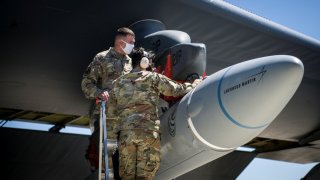When It Comes to Hypersonic Weapons What Is America's Strategy?
The jury is still out on the “strategic implications” of hypersonic weapons, with analysts disagreeing on whether or not these weapons can decisively shape a state’s military capabilities or alter the basic logic of nuclear deterrence.
A recently updated Congressional Research Service (CRS) report offers a comprehensive look at the many complex issues surrounding the U.S. military’s adoption of hypersonic weapons technology.
The report, authored by defense analyst Kelley Sayler, opens with a primer distinguishing between the two main types of hypersonic weapons: hypersonic glide vehicles (HGVs) and hypersonic cruise missiles. The paper then turns to a succinct outline of the hypersonic projects pursued by Russia, China, and the United States For the former, these include the U.S. Navy’s Conventional Prompt Strike (CPS) weapon, the Army’s Long-Range Hypersonic Weapon (LRHW), the Air Force’s Hypersonic Attack Cruise Missile (HACM) and AGM-183 Air-Launched Rapid Response Weapon (ARRW), and DARPA’s Tactical Boost Glide (TBG), Operational Fires (OpFires), and Hypersonic Air-breathing Weapon Concept (HAWC). The Defense Department is also reviewing hypersonic missile defense options, but those proposals are still in a fledgling state. The report notes that U.S. funding for hypersonic weapons programs has increased in recent years, partly to keep pace with growing Russian and Chinese capabilities in this domain. But, whereas the latter two have primarily focused on nuclear-capable hypersonic systems, most U.S. hypersonic weapons are being designed for tactical use. These conventional weapons, posits the report, require greater accuracy and are more difficult to develop than their nuclear counterparts.
The subsequent part turns to the ongoing debate in Washington over the future of hypersonic weapons, centered around four overarching issues: mission requirements, funding, strategic stability, and arms control. The report notes that the Defense Department has not yet established a clear set of operational parameters for hypersonic weapons: “What mission(s) will hypersonic weapons be used for? Are hypersonic weapons the most cost-effective means of executing these potential missions? How will they be incorporated into joint operational doctrine and concepts?”
The CRS report adds that, given the lack of clearly defined mission sets, it is difficult to move forward with optimized budgets that can successfully balance the many costly considerations of hypersonic weapons research, development, production, and deployment. The report notes that the jury is still out on the “strategic implications” of hypersonic weapons, with analysts disagreeing on whether or not these weapons can decisively shape a state’s military capabilities or alter the basic logic of nuclear deterrence. The paper cites some analysts who have argued that current arms control agreements should be expanded to cover certain hypersonic systems, or that entirely new treaties should be negotiated to curtail if not ban the testing of these weapons.
The CRS report underscores just how uncertain Washington’s current hypersonic weapons development plans really are. Some individual projects like the CPS system are proceeding apace, but there is still no long-term procurement and doctrinal approach to hypersonics—what specific mission purpose do these weapons serve, and how do we acquire them in a cost-effective way? As the Pentagon continues to grapple with these core questions, Washington’s rift with Beijing and Moscow in hypersonic technology shows no signs of meaningfully closing over the coming years. Under Secretary of Defense for Research and Engineering (USD[R&E]) Michael Griffin posed the potential risk in stark terms: The U.S. does not “have systems which can hold [China and Russia] at risk in a corresponding manner, and we don’t have defenses against [their] systems,” he said during an earlier testimony to Congress.
Mark Episkopos is a national security reporter for The National Interest.
Image: Reuters

